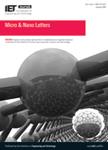版权所有:内蒙古大学图书馆 技术提供:维普资讯• 智图
内蒙古自治区呼和浩特市赛罕区大学西街235号 邮编: 010021

作者机构:Univ Sci & Technol China Dept Precis Machinery & Precis Instrument Hefei 230026 Anhui Peoples R China Anhui Med Univ Sch Life Sci Dept Biomed Engn Hefei 230032 Anhui Peoples R China
出 版 物:《MICRO & NANO LETTERS》 (Micro. Nano. Lett.)
年 卷 期:2018年第13卷第11期
页 面:1604-1608页
核心收录:
基 金:National Natural Science Foundation of China 973 Project [2014CB931804] NSFC-CAS Joint Fund [U1332130] Key Research and Development Program of Anhui [1704a0902051] 111 the Projects [B07033]
主 题:tissue engineering biomedical materials bone crystallisation polymers melt processing laser sintering melting point blending powders polymer structure heat treatment melting point PLA stereocomplex-based three-dimensional scaffold selective laser sintering SLS PLA system bioresorbable polymer bone tissue repair low heat distortion temperature biomedical applications rapid prototyping technology PLA products PLA stereocomplex formation melt blending tissue engineering scaffolds superheat deflection resistance stereocomplex crystallisation fused deposition modelling poly(D-lactide) energy density scan speed preheating temperature microstructure rough powder surface crystallinity scan spacing
摘 要:Polylacite (PLA) is a bioresorbable polymer with potential application for bone tissue repair;however, low heat distortion temperature (HDT) limits its biomedical applications. Due to the low-melting point of PLA, only fused deposition modelling (FDM) was used as a rapid prototyping technology to form PLA products. Here, the work presents a PLA stereocomplex formation which was facilitated by melt blending PLA and poly(D-lactide). The melting point was successfully increased to 219.2 degrees C. Besides, the PLA stereocomplex-based three-dimensional scaffold was formed by selective laser sintering (SLS). The parameters of SLS (energy density, scan speed, scan spacing, preheating temperature etc.) were also optimised by comparing the microstructure. Compared with the FDM, the SLS provides many benefits for fabricating tissue engineering scaffolds due to its rough powder surface. Results show that the PLA stereocomplex was successfully obtained and crystallinity of the stereocomplex was 59.7%.